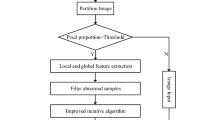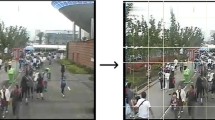Abstract
The objective of this work is to leverage the clues obtained from mani-fold sources, to figure out the density of people existent in exceptionally dense crowded regions. The complications in crowd density estimation include perspective effect, occlusion, clutter background, textured brick surface, and few pixels per target. In crowd scenarios with these complications, detection based techniques are not accurate, even none of the single feature alone is suitable to estimate crowd density. Therefore, our methodology depends on mani-fold sources such as head detection with low confidence, recurrence of texture elements by using frequency domain, wavelet and scale invariant feature transform (SIFT) descriptor to measure the density count. The information obtained from manifold sources is used to train a support vector machine (SVM), which generates a patch count estimation. Next, a Gaussian-based Markov Random Field (MRF) is applied on image patches to obtain uniformity on crowd count. The Gaussian MRF furnishes the discrepancy in crowd count along with local neighborhoods at multiple scales. We tested our approach on four different datasets such as Shanghai Tech_A, UCF_CC_50, extended UCF_CC_100 and UCSD. The former three datasets are a crisp contrast to existing crowd datasets used in literature which contains almost hundreds or tens of individuals in crowd images. The latter UCSD dataset is used to test the robustness of our technique in low-density crowd too. We compare the proposed method with both traditional and convolutional neural network (CNN) based approaches. Low computational complexity indicates that the proposed technique provides decent performance rate and can be employed in real-world applications. Our experimental results validate the adequacy and efficiency of the intended methodology by measuring the density of crowd images.







Similar content being viewed by others
References
Arandjelovic O (2008) Crowd detection from still images. In: BMVC 2008: proceedings of the british machine vision association conference 2008. BMVA press, pp 1–10
Ariffin A, D’Oorazio C, Choo KKR, Slay J (2013) ios forensics: how can we recover deleted image files with timestamp in a forensically sound manner?. In: 2013 eighth international conference on availability, reliability and security (ARES). IEEE, pp 375–382
Ariffin A, Slay J, Choo KK (2013) Data recovery from proprietary formatted CCTV hard disks. In: IFIP international conference on digital forensics. Springer, pp 213–223
Azencott R, Wang J-P, Younes L (1997) Texture classification using windowed fourier filters. IEEE Trans Pattern Anal Mach Intell 19(2):148–153
Bansal A, Venkatesh K (2015) People counting in high density crowds from still images. arXiv:1507.08445
Brostow GJ, Cipolla R (2006) Unsupervised bayesian detection of independent motion in crowds. In: 2006 IEEE computer society conference on computer vision and pattern recognition, vol 1. IEEE, pp 594–601
Chan AB, Vasconcelos N (2009) Bayesian poisson regression for crowd counting. In: 2009 IEEE 12th international conference on computer vision. IEEE, pp 545–551
Chan AB, Liang Z-SJ, Vasconcelos N (2008) Privacy preserving crowd monitoring: counting people without people models or tracking. In: IEEE conference on computer vision and pattern recognition, 2008. CVPR 2008. IEEE, pp 1–7
Chang T, Kuo C-C (1993) Texture analysis and classification with tree-structured wavelet transform. IEEE Trans Image Process 2(4):429–441
Chen K, Loy CC, Gong S, Xiang T (2012) Feature mining for localised crowd counting. In: BMVC, vol 1. p 3
Chen K, Gong S, Xiang T, Change Loy C (2013) Cumulative attribute space for age and crowd density estimation. In: Proceedings of the IEEE conference on computer vision and pattern recognition, pp 2467–2474
Chen S, Fern A, Todorovic S (2015) Person count localization in videos from noisy foreground and detections. In: Proceedings of the IEEE conference on computer vision and pattern recognition, pp 1364–1372
Cho S-Y, Chow TW, Leung C-T (1999) A neural-based crowd estimation by hybrid global learning algorithm. IEEE Trans Syst Man Cybern B Cybern 29(4):535–541
Cross GR, Jain AK (1983) Markov random field texture models. IEEE Trans Pattern Anal Mach Intell 1:25–39
Dalal N, Triggs B (2005) Histograms of oriented gradients for human detection. In: IEEE computer society conference on computer vision and pattern recognition, 2005. CVPR 2005, vol 1. IEEE, pp 886–893
Davies AC, Yin JH, Velastin SA (1995) Crowd monitoring using image processing. Electronics & Communication Engineering Journal 7(1):37–47
Dollar P, Wojek C, Schiele B, Perona P (2012) Pedestrian detection: an evaluation of the state of the art. IEEE Trans Pattern Anal Mach Intell 34(4):743–761
Felzenszwalb P, McAllester D, Ramanan D (2008) A discriminatively trained, multiscale, deformable part model. In: IEEE conference on computer vision and pattern recognition, 2008. CVPR 2008. IEEE, pp 1–8
Felzenszwalb PF, Girshick RB, McAllester D, Ramanan D (2010) Object detection with discriminatively trained part-based models. IEEE Trans Pattern Anal Mach Intell 32(9):1627–1645
Fu M, Xu P, Li X, Liu Q, Ye M, Zhu C (2015) Fast crowd density estimation with convolutional neural networks. Eng Appl Artif Intell 43:81–88
Ge W, Collins RT (2009) Marked point processes for crowd counting. In: IEEE conference on computer vision and pattern recognition, 2009. CVPR 2009. IEEE, pp 2913–2920
Hussain N, Yatim HSM, Hussain NL, Yan JLS, Haron F (2011) Cdes: a pixel-based crowd density estimation system for masjid al-haram. Saf Sci 49(6):824–833
Idrees H, Saleemi I, Seibert C, Shah M (2013) Multi-source multi-scale counting in extremely dense crowd images. In: Proceedings of the IEEE conference on computer vision and pattern recognition, pp 2547–2554
Kang D, Ma Z, Chan AB (2017) Beyond counting: comparisons of density maps for crowd analysis tasks-counting, detection, and tracking. arXiv:1705.10118
Kratz L, Nishino K (2009) Anomaly detection in extremely crowded scenes using spatio-temporal motion pattern models. In: IEEE conference on computer vision and pattern recognition, 2009. CVPR 2009. IEEE, pp 1446–1453
Krizhevsky A, Sutskever I, Hinton GE (2012) Imagenet classification with deep convolutional neural networks. In: Advances in neural information processing systems, pp 1097–1105
Lamba S, Nain N (2017) Crowd monitoring and classification: a survey. In: Advances in computer and computational sciences. Springer, pp 21–31
Lamba S, Nain N (2017) Multi-source approach for crowd density estimation in still images. In: 2017 IEEE international conference on identity, security and behavior analysis (ISBA). IEEE, pp 1–6
Lamba S, Nain N, Chahar H (2016) A robust multi-model approach for face detection in crowd. In: 2016 12th international conference on signal-image technology & internet-based systems (SITIS). IEEE, pp 96–103
Lempitsky V, Zisserman A (2010) Learning to count objects in images. In: Advances in neural information processing systems, pp 1324–1332
Leung T, Malik J (1999) Recognizing surfaces using three-dimensional textons. In: The proceedings of the seventh IEEE international conference on computer vision, 1999, vol 2. IEEE, pp 1010–1017
Li M, Zhang Z, Huang K, Tan T (2008) Estimating the number of people in crowded scenes by mid based foreground segmentation and head-shoulder detection. In: 19th international conference on pattern recognition, 2008. ICPR 2008. IEEE, pp 1–4
Lin S-F, Chen J-Y, Chao H-X (2001) Estimation of number of people in crowded scenes using perspective transformation. IEEE Trans Syst Man Cybern Part A Syst Humans 31(6):645–654
Ma R, Li L, Huang W, Tian Q (2004) On pixel count based crowd density estimation for visual surveillance. In: 2004 IEEE conference on cybernetics and intelligent systems, vol 1. IEEE, pp 170–173
Ma W, Huang L, Liu C (2010) Crowd density analysis using co-occurrence texture features. In: 2010 5th international conference on computer sciences and convergence information technology (ICCIT). IEEE, pp 170–175
Marana A, Costa LDF, Lotufo R, Velastin S (1998a) On the efficacy of texture analysis for crowd monitoring. In: International symposium on computer graphics, image processing, and vision, 1998. Proceedings. SIBGRAPI’98.IEEE , pp 354–361
Marana AN, Velastin SA, Costa LDF, Lotufo R (1998b) Automatic estimation of crowd density using texture. Saf Sci 28(3):165–175
Marana AN, Costa LDF, Lotufo R, Velastin SA (1999) Estimating crowd density with minkowski fractal dimension. In: 1999 IEEE international conference on acoustics, speech, and signal processing, 1999. Proceedings, vol 6. IEEE, pp 3521–3524
Marsden M, McGuiness K, Little S, O’Connor NE (2016) Fully convolutional crowd counting on highly congested scenes. arXiv:1612.00220
Miraftabzadeh SA, Rad P, Choo KKR, Jamshidi M (2017) A privacy-aware architecture at the edge for autonomous real-time identity re-identification in crowds. IEEE Internet of Things Journal. [In press]
Rabaud V, Belongie S (2006) Counting crowded moving objects. In: 2006 IEEE computer society conference on computer vision and pattern recognition, vol 1. IEEE, pp 705–711
Rodriguez M, Laptev I, Sivic J, Audibert J-Y (2011) Density-aware person detection and tracking in crowds. In: 2011 IEEE international conference on computer vision (ICCV). IEEE, pp 2423–2430
Ryan D, Denman S, Fookes C, Sridharan S (2009) Crowd counting using multiple local features. In: Digital image computing: techniques and applications, 2009. DICTA’09. IEEE, pp 81–88
Sabzmeydani P, Mori G (2007) Detecting pedestrians by learning shapelet features. In: IEEE conference on computer vision and pattern recognition, 2007. CVPR’07. IEEE, pp 1–8
Srinivasan GN, Shobha G (2008) Statistical texture analysis. In: World academy of science, engineering and technology, vol 36. pp 1264–1269
Vedaldi A, Fulkerson B (2010) Vlfeat: an open and portable library of computer vision algorithms. In: Proceedings of the 18th ACM international conference on multimedia. ACM, pp 1469–1472
Viola P, Jones MJ (2004) Robust real-time face detection. Int J Comput Vis 57(2):137–154
Wang X, Ma X, Grimson E (2007) Unsupervised activity perception by hierarchical bayesian models. In: IEEE conference on computer vision and pattern recognition, 2007. CVPR’07. IEEE, pp 1–8
Wang C, Zhang H, Yang L, Liu S, Cao X (2015) Deep people counting in extremely dense crowds. In: Proceedings of the 23rd ACM international conference on multimedia. ACM, pp 1299–1302
Wu B, Nevatia R (2005) Detection of multiple, partially occluded humans in a single image by bayesian combination of edgelet part detectors. In: Tenth IEEE international conference on computer vision, 2005. ICCV 2005, vol 1. IEEE, pp 90–97
Wu B, Nevatia R (2007) Detection and tracking of multiple, partially occluded humans by bayesian combination of edgelet based part detectors. Int J Comput Vis 75 (2):247–266
Xiaohua L, Lansun S, Huanqin L (2006) Estimation of crowd density based on wavelet and support vector machine. Trans Inst Meas Control 28(3):299–308
Xu Z, Zhang H, Hu C, Mei L, Xuan J, Choo KKR, Sugumaran V, Zhu Y (2016) Building knowledge base of urban emergency events based on crowdsourcing of social media. Concurrency and Computation: Practice and Experience 28(15):4038–4052
Zhang C, Li H, Wang X, Yang X (2015) Cross-scene crowd counting via deep convolutional neural networks. In: Proceedings of the IEEE conference on computer vision and pattern recognition, pp 833–841
Zhang Y, Zhou D, Chen S, Gao S, Ma Y (2016) Single-image crowd counting via multi-column convolutional neural network. In: Proceedings of the IEEE conference on computer vision and pattern recognition, pp 589–597
Zhu S-C, Guo C-E, Wu Y, Wang Y (2002) What are textons?. In: European conference on computer vision. Springer, pp 793–807
Author information
Authors and Affiliations
Corresponding author
Rights and permissions
About this article
Cite this article
Lamba, S., Nain, N. A texture based mani-fold approach for crowd density estimation using Gaussian Markov Random Field. Multimed Tools Appl 78, 5645–5664 (2019). https://doi.org/10.1007/s11042-017-5554-4
Received:
Revised:
Accepted:
Published:
Issue Date:
DOI: https://doi.org/10.1007/s11042-017-5554-4




